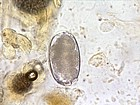Difference between revisions of "Category:Strongyloidea"
Jump to navigation
Jump to search
| Line 1: | Line 1: | ||
| − | <categorytree mode=pages | + | {{frontpage |
| + | |pagetitle =Strongyloidea | ||
| + | |pagebody = | ||
| + | |contenttitle =Content | ||
| + | |contentbody =<big><b> | ||
| + | <br> | ||
| + | <categorytree mode=pages>Strongyloidea</categorytree> | ||
| + | </b></big> | ||
| + | |logo = | ||
| + | }} | ||
== General Appearance == | == General Appearance == | ||
Revision as of 11:20, 21 May 2010
Strongyloidea
General Appearance
- Bursate
- Large buccal capsule
- Relatively short (typically 1-5cm) but stout
- Heads often have characteristic features - teeth or cutting plates
General Life-Cycle
- Like that of the trichostrongyloids (eggs are also 'typical strongyle eggs'), but:
- L3 → L4 → adult (typically occurs in the large intestine)
- Larvae penetrate the mucosal wall and elicit nodule formation
- Larvae of some species migrate around the body
- Prepatent period varies between species from 3 weeks to over 6 months
Peritonitis in sheep by penetration of intestines by larvae of Oesophagostomum columbianum
Strongylus edentatus and Strongylus equinus migrate through Peritoneal Cavity Parasitic - Pathology
Stephanuris dentatus causes peritonitis in pigs Peritoneal Cavity Parasitic - Pathology and may cause cysts in the pancreas
Syngamus laryngeus in larynx of cattle
<ncl style=bullet maxdepth=5 headings=bullet headstart=2 showcats=1 showarts=1>Category:Strongyloidea</ncl>
Pages in category "Strongyloidea"
The following 6 pages are in this category, out of 6 total.
